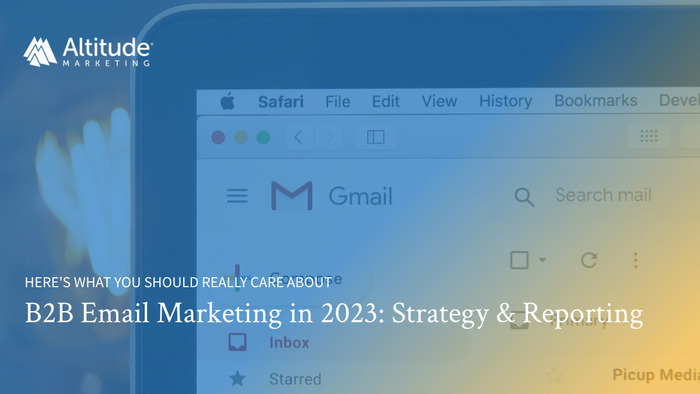“Email” is a broad set of marketing initiatives. Thus, a dive into the topic will always feel (and be) incomplete. That said, we strive here to offer a slightly-deeper-than-surface view into what is necessary for a high-performing B2B email marketing program in 2023.
Email marketing isn’t going anywhere.
But email analytics are getting a bit more complicated.
Open rates can be misleading. More and more emails are going missing or getting caught in spam filters. Email servers are stricter than ever.
So, how do you know what’s working and what’s not?
Here’s where this complexity leaves B2B marketers with email marketing strategies in 2023 – starting with a quick overview of the different types of emails you might be sending.
Types of B2B Email Marketing in 2023
Email marketing can be broadly broken down into four areas:
- Mass send emails are sent by hand (or by schedule) to a defined list or segment. This is analogous to the “email newsletter” of 2010.
- Automated emails are delivered automatically according to predefined criteria. An example is a string of messages designed to incentivize a user to schedule a meeting using Calendly, or to “nurture” a contact who has requested a specific white paper.
- Transactional emails are automated and triggered by a specific event. Examples are thank you emails after a form, or a receipt from eCommerce.
- Commercial emails are designed to sell a specific product. These are more common in B2C marketing than B2B marketing, but are still deployed in some instances.
Each type of email campaign requires a different strategy and reporting impetus, as goals (should) vary dramatically.

B2B Mass Send Emails: Strategy & Reporting
By and large, mass send emails are meant to put as many eyeballs as possible on a piece or tranche of content. This could be an announcement, a post or a downloadable asset.
Strategically, these are typically designed to maximize visibility. As such, reporting takes several forms:
Opens
Opens are poor measurements of B2B email marketing performance in 2023. Accuracy is barely more than a guess.
However, opens are worth noting in the context of an existing list or baseline, or the establishment of a baseline.
Consistency is the key – an ActiveCampaign open rate cannot and should not be compared with a HubSpot open rate in a different industry. What you’re looking for here is specific issues or anomalies, not a percentage point or two.
Open rate and the absolute number must be reported together. Either out of context means effectively nothing.
Clicks
Clicks matter if the goal is to drive website or landing page traffic. This is not always the case.
There are many cases where visibility in the inbox is just as valuable as website traffic. Event attendance is one example. That Company X will be a tradeshow Y is one thing – there’s rarely a good reason to click through. That Company X will be presenting Abstract Y at Conference Z is very different; a scientific audience likely wants to see any pre-present data we can make available. Thus, this metric varies dramatically in terms of import.
“Full-email” clicks must be removed from click numbers. More and more email clients check every link in the email for malware. These are not human behavior and should be discounted.
Conversions
In the event that a specific asset is being offered up (e.g., a white paper or a webinar slot), conversions are the most critical measurement.
Either a button click or a pre-filled form should be utilized for opt-in, depending on the amount of full-email clicks seen in the past. A blank form is almost never acceptable – it’s an unnecessary hurdle to conversion and poor UX.
Automated Emails: Strategy & Reporting
An automated email string must have a distinct purpose. It is no longer impressive to “nurture” contacts by sending stuff. These represent little more than things to fill a spam folder, and statistics dictate that individual response is vanishingly small.
Instead, the big picture matters:
- Are we looking for a free trial -> paid user conversion?
- A meeting using Calendly?
- A slightly warmer call with sales that’s already been scheduled?
Every touchpoint must be intentional.
Deliverability & Opens
Deliverability and opens are key metrics here. Since we’re deploying individualized messaging (“You did X. Y is the next step.”) in a distinct forum, eyeballs matter. If we’re sending to 10,000 users, it’s OK if 1,000 don’t get there. If we’re sending to one, a single miss is a huge problem. These don’t reflect email quality but instead tech stack and deliverability methodology (e.g., verification at the domain level).
Conversions
Conversions are the real metric. A click without one is meaningless. What’s the goal of a specific automation? That is the win or lose stat.
Transactional Emails: Strategy & Reporting
Transactional emails are typically of relatively low value in the grand scheme – they are reactionary and ephemeral. The real measurable is brand impression.
Are we offering a positive user experience? Are we improving the perception of the brand? This is qualitative – but critical. A click or conversion is largely misplaced here. They’ve taken the action already!
Commercial Emails: Strategy & Reporting
Commercial emails are simple things: They’re meant to sell something. Thus, reporting is simple:
Deliverability & Opens
Deliverability and opens track reach. A user can’t buy if they don’t see. A poor subject, for instance, or bad domain verification limits the audience, and thus revenue.
Sales
Sales matter more than anything. How many did we make? How many times was a coupon code used? What was the AOV? And what was total revenue?
tl;dr: B2B Email Marketing Strategy for in 2023
B2B email marketing is an important distribution strategy for marketers, but measuring success is getting more difficult. These metrics for each type of email will help you figure out what’s really important.



